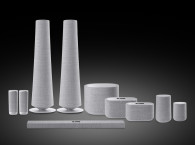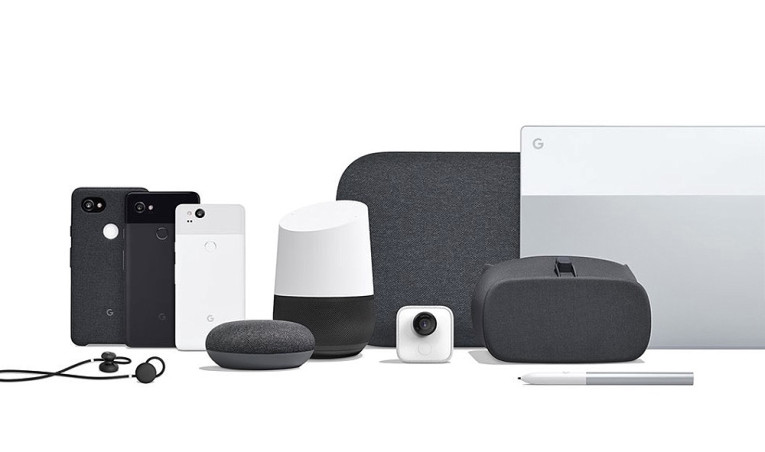
"We see tremendous potential for devices to be helpful, make your life easier, and even get better over time when they’re created at the intersection of hardware, software and advanced artificial intelligence (AI)," says Rick Osterloh, Google's Senior Vice President, Hardware. Notice the reference to Steve Jobs' famous description of Apple's vision, on the "intersection of technology and the liberal arts."
It wasn't a coincidence that the announcements by Google were made in a staged event where the company introduced its new-generation Pixel smartphones – no longer a reference design for Chinese Android smartphone-makers – but a product that is intended to compete head-to-head with the iPhone. "These days many devices — especially smartphones — look and act the same. That means in order to create a meaningful experience for users, we need a different approach," states Osterloh.
That differentiation is described as the "intersection of hardware, software and advanced artificial intelligence (AI)." Google is determined to differentiate its offerings with advanced applications such as its voice personal assistant (Google Assistant), but also through the integration of hardware and software in the smart home and mobile experiences – in a way trying to regain the space that Amazon unexpectedly conquered in a short period of time.
In this two-front war, Google needs to sell "better and faster" devices to the consumer, with enough power to bring its software technologies to its full potential, without being dependent on third-party hardware manufacturers that will always inevitably be years behind. And that software and connected services need to run in all classes of "smart devices", no longer being tied to standard computers. Google is recognized as the pioneer of search engines, voice recognition, language translation, maps, image recognition, and many other areas that, until now, depended always of hardware processing and connectivity made by others.
Recently, Google bought HTC – one of its regular manufacturing partners for earlier reference-hardware projects – and expanded production in all fronts, including smart speakers, streaming devices, cameras, etc. The only thing missing – in direct contrast with Amazon and Apple – is a dedicated distribution platform. Amazon is the recognized leading online retailer, while Apple completely controls its global distribution channels, including its own amazingly lucrative network of Apple Stores, which not even Microsoft or Samsung have been able to emulate.
But let’s look at the products that Google unveiled, which have all been promoted to be available "asap" at very aggressive prices. First off, is the new "Made by Google" Pixel 2 smartphone, featuring an improved camera, improved display and augmented reality capabilities (sound familiar?). Bundled with the very traditional-looking Pixel 2 design, Google will try to increase the value of its own hardware with "unlimited storage" for photos and videos, Youtube Music accounts and access to its own connected services. Significantly the new Pixel 2 models are now USB-C only devices, without the previously “indispensable” 3.5mm headphone mini jack.
Next up is a new Pixelbook, that Google calls a "reimagined high-performance Chromebook laptop" that actually is a direct-hit at the Microsoft Surface range, even though it was very much inspired by Apple's powerful iPad Pro, pencil included and all (called the Pixelbook Pen). Again, the important thing here is that Google promotes it as "the first laptop with the Assistant built in," because this new range of hardware devices is all about voice. Across all the new devices, users can interact with the Google Assistant seamlessly, and all the devices, including a new always-on AI camera, connect to Google's information centers – all the time.
The new Home Speakers
Google introduced two new speakers to its Home range, both designed to compete directly in the same class as the new Amazon Echo Dot, and the Amazon Echo Plus (or the upcoming Apple HomePod). Competing with the new Echo Dot is the new Google Home Mini, designed to bring the Google Assistant to more places throughout the home, with a friendlier design.
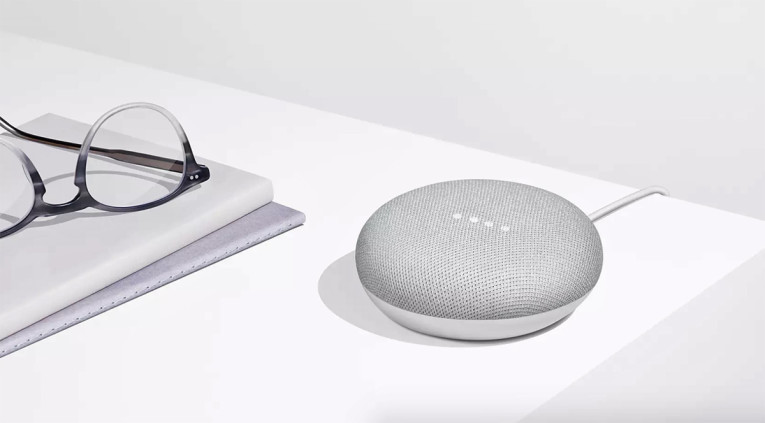
The Google Home Mini is a small device, designed to be a hands-free assistant in every room. Featuring a round, pebble-like, shape, with no corners or edges, and "about the size of a donut," the Home Mini is wrapped in a special fabric, that Google says is simultaneously durable, yet transparent to let through both light and sound. The LEDs under the fabric light up to show the user when the Assistant is listening. And it projects and captures 360-degree sound using far-field microphones, even when there’s music playing or there’s other noise in the background. The Home Mini comes in three colors – Chalk, Charcoal and Coral – will cost just $49, and will be available in stores starting October 19, in the U.K., Canada, Germany, France, Australia, and soon Japan.
Competing in the larger category of living-room speakers designed also to play music at louder volumes, Google introduced the Home Max, which the company calls "our biggest and best-sounding Google Home device, powered by the Assistant." Like the upcoming Apple HomePod, the Home Max can listen and adapt automatically to the surrounding environment, context, and user preferences, featuring six far-field microphones. Since it is designed to be a home device it requires a power adaptor and doesn't include a battery for portable use.
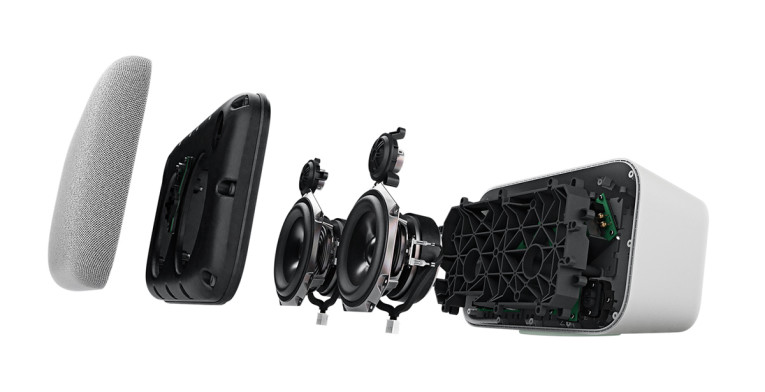
The new Google Home Max is designed to capture a share of the same market that Apple anticipated with the HomePod – a speaker with quality sound that people will buy for playing music, first and foremost. Featuring "high-fidelity sound," in Google's own words, the Home Max features dual 4.5-inch (114 mm) high-excursion dual voice-coil woofers, two 0.7-inch (18 mm) tweeters, and enough power to play loud and be a main living-room system. Google explains that the Home Max is “20 times more powerful than the original Google Home.” But the Home Max also features a combination of sensors and DSP, providing echo cancellation, noise and acoustic room compensation, to provide "a new audio experience powered by Google’s artificial intelligence," that automatically adjusts to any room and dynamically tunes the sound to any position within that room "in just seconds." The design is similar to a Sonos large speaker – in fact its sits in between the Play:3 ($299), and the Play:5 ($499) in both price and size – but with the difference that it can be placed vertically or horizontally.
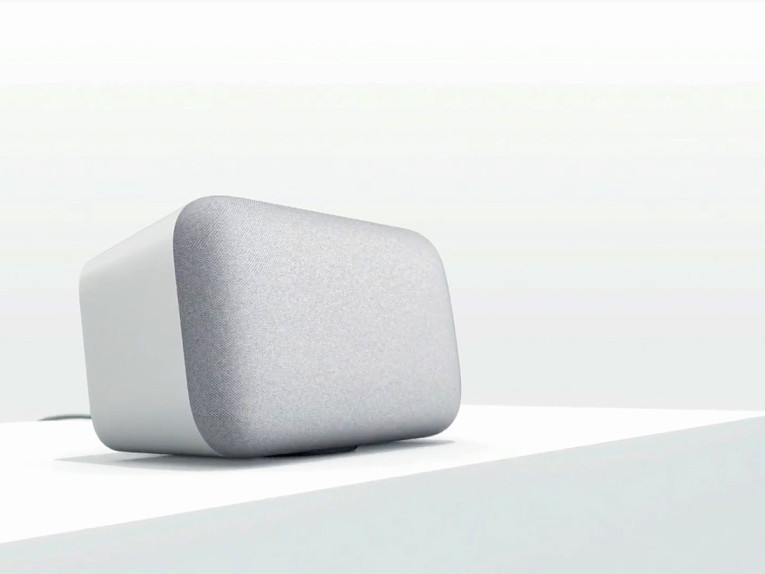
Naturally, both speakers will support all Google Chromecast features and will be compatible with any other Chromecast Audio device, creating multiroom configurations, and supporting a wide range of streaming music services – except for Apple Music, naturally. Apart from connecting via Wi-Fi, the Home Max uses Bluetooth 4.2 and features USB-C (to connect to a physical network and support digital audio), and a 3.5mm auxiliary port. The Google Home Max will launch in the U.S. for $399 and comes with 12 months of ad-free YouTube Music service.
Google Wireless Headphones
Finally, Google unveiled a completely new product category for the brand, but something that clearly fits within the logic of competing head-to-head with Apple and other companies, as a complement to its now "jackless" Pixel 2 smartphone, but also making an entrance in the wearables space. The new Pixel Buds are wireless earbuds that are designed as "truly wireless" with the difference that they actually use a “string” to connect both earbuds. It is a strange option, given that the fabric wire doesn’t “connect” to the earbuds. If there was effectively a cable inside, it could be used to avoid the all-too-familiar synchronization problems. Without it, we will need to know more about the specs to understand how they avoid the typical connection and lagging problems of other earbuds
They are "hearables", because Google designed the Pixel Buds to be "smart", providing another way to access the Google Assistant using touch controls and even helping users to access translation services – one of the arguments that many wireless earbud companies have been targeting. According to Adam Champy, Product Manager for Google Pixel Buds, these are headphones designed to do more than listen to music. "These wireless headphones not only sound great, they are seamless to use and charge, offer help from the Google Assistant, and have a few extra smarts so you can get the answers you need while keeping your eyes up," he states.
The design is simple and light, providing a universal fit, and they are distinct with its fabric loop, that not only makes the earbuds more comfortable, secure, and quick to adjust, but also avoid problems with loosing or misplacing one of the units. All the audio controls - a touchpad – are concentrated on the right earbud, so there aren’t any buttons hanging on the cord. Users can swipe forward or backward to control volume and tap to play or pause music. Storing the earbuds on the pocket-sized charging case provides up to 24 hours of listening time – while the earbuds should provide around five hours of standard use (doubtful considering the size…). Pairing the earbuds requires the user to open the charging case near any Pixel or Android smartphone, running Android 7.0 Nougat or higher, and compatible with the Assistant, and the earbuds will be automatically detected. The user receives a message to connect.
By touching and holding the right earbud – the one with the touchpad – users can ask the Google Assistant to play music, make a phone call, or get directions, keeping the phone in the pocket. The Assistant will provide user-configurable calendar alerts, incoming messages, and even read messages if instructed to do so, for hands-free situations, like driving. Using the phone connection and the Google Translate app on the Pixel smartphones, users can receive language translations in real time on the Pixel Buds. It requires a connection to the service but, for simple words and sentences, it will work in 40 languages.
Given the simple and light design, the sound quality can be affected by the fitting in different users, but Google doesn't intend to attract audio enthusiasts with this product, designed essentially to "test the grounds" on the hearable category. The new Pixel Buds come in three colors — Just Black, Clearly White and Kinda Blue — to match the same finishes of the Pixel 2 smartphones, even though they are sold separately, available in November for $159 in the U.S., and coming to Canada, U.K., Germany, Australia and Singapore in November 2017.
Just Getting Started
A key differentiator, Google claims its Assistant is "the only assistant that recognizes your voice, and up to five others in your home." The multiple user feature is called Voice Match, and enables different household members to get personalized help on a shared device. The Assistant recognizes different voices and responds with the user's news preferences, calendar, commute, and reminders. Only available on Google Home devices. The Google Assistant also has two new voice options, for users in the U.S. Another area that Google will start exploring is payments. The service will allow purchases, starting with 1-800-Flowers, Applebee’s, Panera and Ticketmaster, only in the U.S.
The company also announced some new features and improvements for its VPA, including multiple scenarios for home automation control. The user can just say “Hey Google, goodnight!” to automatically turn off the lights, turn down the temperature, and provide information on tomorrow’s first scheduled meeting or event. Users will also be able to say, “Hey Google, broadcast it’s time to leave for soccer practice!” and the message will play on the other Google Home devices around the house. Like Amazon, Google is also designing entertainment "experiences" for users to explore the voice interactions, including an intriguing reference to content provided by Disney and Marvell characters, which is very strange, considering Disney's direct connections to Apple. On the home automation front, Google also unveiled collaborations with more than 1,000 smart home products from 100+ brands, that can now be controlled just using voice.
In terms of language support, the Google Assistant is available in Google Home devices in the U.K., Canada (English and French), Australia, Germany, France and, now also Japan. The Assistant on eligible Android phones and iPhones is also available in Brazilian Portuguese, Japanese, Korean and, coming soon, Italian, Spanish (in Mexico and Spain) and Singaporean English.
Google’s hardware business is just getting started. As Google states, "we’re committed to building and investing for the long run," expanding a family of products that "truly brings together the best of Google software, thoughtfully designed hardware with cutting-edge AI."
www.google.com




